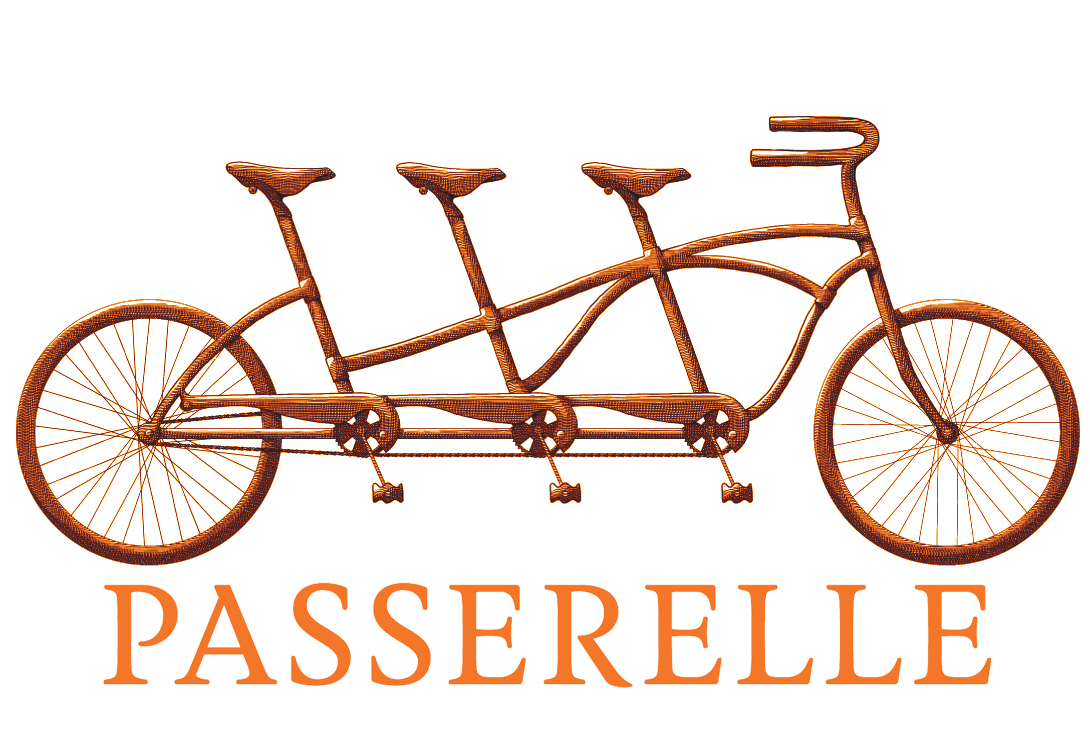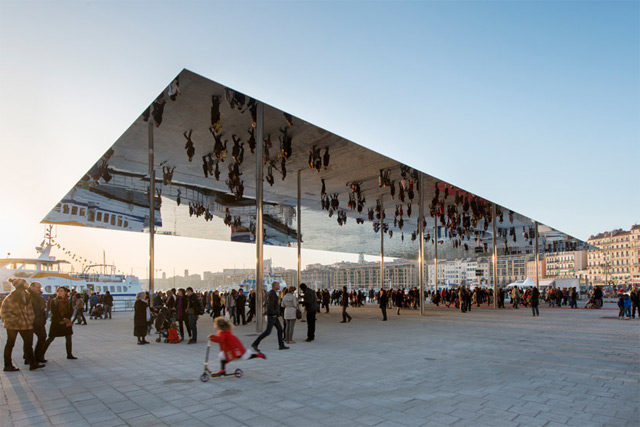This is a fantastic article synthesizing the most important qualities that make for successful pedestrian-friendly spaces. They are: imageability, enclosure, human scale, transparency, complexity, coherence, legibility, and linkage. Learn more about what these words mean here.
Cool Mirrored Canopy: The Port Vieux Pavilion
On The Value of Public-Private Partnerships
Public-private partnership is an important option that can be utilized in times of economic uncertainty and in periods of prosperity. There is a nexus between the public sector’s needs and the private sector’s goals. ~Doug Domenech
Downtown Revitalization in Syracuse
5 Urban Technology Trends Impacting City Planning
Here is Streetline's article that outlines 5 cool new ways technology can improve the urban environment: Traffic Management, Smart Utilities, Sidewalk Tiles that Generate Electricity, 3-D Modelling, and Online Civic Involvement. Awesome!

Belgium's Pop-Up Shipping Container Hotel
Check out Belgium's Pop-Up Shipping Container Hotel!

"When you book a night's stay at Belgium's Sleeping Around Hotel, you'll need your GPS to find it." - Bridgette Meinhold
Not Just Green Walls...Flowered Walls!
Check out these green wall ideas - we particularly like the wall-flower concept!
Cool Looping Bridge
The 20 Most Important Restaurants in the US for 2013
Although a Valentine's Day reservation may be a bit too late to make now, you still have the remainder of the year to check out the 20 Most Important Restaurants for 2013. Los Gatos, Napa, and San Francisco are featured on this list by Bon Appetit magazine! Bon appétit!
Ways to Beautify The Streetscape
Just some cool links we like, about hiding utility boxes, and rain-activated street art! Enjoy!

Passerelle Selected as Finalist in Acterra Sustainability Award Competition!
Check it out - Passerelle is on the list of Finalist candidates for the Acterra Award for Sustainability! Here is Acterra's description of its Acterra Award for Sustainability: "Acterra’s highest award recognizes businesses whose programs achieve significant triple bottom line benefits (people, planet, profit) and advance the state of sustainability in a given industry or across industry sectors. Model programs are established and holistic; promoting sustainability throughout the entire value chain and permeating most key business functions."
Want to learn more? Click here to learn more about Acterra, or click here to learn about its Business Environmental Awards program. Wish us luck!
110 First Celebrates Its LEED Platinum Status
Thanks to all who helped us celebrate our office building's long-awaited LEED-Platinum award last Wednesday, January 16th! Mayor Pro Tem Megan Satterlee was on hand to unveil our brand new LEED-Platinum plaque that now lives on the wall of the lobby at 108-110 First Street, where Evolve and Passerelle are both located. We want to especially thank our dedicated design and construction team, including Huntsman Architects, BCCI, ACCO, Sprig Electric, Rumsey, and most importantly project manager Laura Billings of Sage Green Development. Check out the press coverage in the Los Altos Patch! To learn more about the green features of the project, check out our 110 First Street portfolio page.
[gallery columns="1"]
Passerelle again nominated for an Acterra Business Environmental Award
Though Passerelle didn't win anything last year, we're at it again, hoping for a 2013 Acterra Award for Sustainability. We've made the just-released list of nominees (which simply means we submitted an application), and the finalists will be announced in February. Cross your fingers, we sure are!
Packard Foundation ULI Tour a Success
I have been volunteering with the Urban Land Institute's Silicon Valley group, helping to coordinate events related to local urban planning real estate development topics. Last month, I helped organize a tour of the Packard Foundation's new headquarters, a LEED-Platinum building in downtown Los Altos with an enviable array of green features. Many thanks to the Packard Foundation folks for generously allowing their office space to be taken over for an hour or so! Check out what the ULI newsletter had to say about the tour.
Bumble, Play!, and Area 151 in San Jose Business Journal!
Check out this November 9 article in the San Jose Business Journal about Mary Heffernan, owner of Bumble, Play! and Area 151: "Kid-oriented businesses break into Los Altos" !
106-110 First Street is a Certified LEED-Platinum Building!
More good news today - Passerelle's office building at 106-110 First Street was just awarded the highest green building rating possible, LEED-Platinum for Commercial Interiors, by the US Green Building Council for its retrofit of the original 1992 structure in 2011. Shared with Evolve, a pilates and fitness studio (106 First), Passerelle's office space at 108 First enjoys many green building features. Photovoltaic and solar thermal roof panels, electric car charging stations, employee bicycle storage and shower facilities, low-VOC paint and products, recycled-content and local materials wherever possible, water-efficient fixtures, and a living wall factored into the building's LEED-Platinum designation. We are so proud! More to come once we install the LEED-Platinum plaque in the building. Go green!

Passerelle Awarded Bicycle-Friendly Business Status!
You've seen it in our logo, now there's a nice award showing that we at Passerelle also walk the walk (roll the ride?) when it comes to being bicycle friendly. Yesterday, the League of American Bicyclists awarded Passerelle a Silver Award for being a Bicycle Friendly Business, along with 70 other new businesses across the country. Check out the great press release here! To date, nearly 500 businesses in 42 states have been awarded this distinction, with more on the way each year. In addition to certifying Bicycle-Friendly Businesses, the League also certifies Bicycle-Friendly Communities, of which Los Altos is a proud member at the Bronze Level. As more Los Altos businesses attain BFB certification, this could help push Los Altos up in the rating scale towards attaining Gold! If you are interested in learning more about the BFB certification process, please contact Brooke Ray Smith, and if you'd like to learn more about Los Altos' BFC designation, Jim Gustafson is the City's liaison.
Study Finds Shopping Local Generates Almost Four Times the Economic Benefit
A new study conducted in Salt Lake City, Utah, has found that indies generate almost four times as much economic benefit for the surrounding region as do chains. The study, “Indie Impact Study Series: A National Comparative Survey With the American Booksellers Association: Salt Lake City, Utah,” stressed that a market shift of just 10 percent from chains to independents would keep an additional $362 million in the regional economy every year. The study was conducted by the research firm Civic Economics and was sponsored by Local First Utah. The study is part of the Indie Impact Study Series, a nationwide research project, being conducted by Civic Economics in partnership with the American Booksellers Association.
“Other studies across the country, from Austin to San Francisco to Chicago have been very helpful to all of us in our efforts to further the local movement,” said Betsy Burton, co-chair of Local First Utah, co-owner of the The King’s English Bookshop, and an ABA Board member. “But having the actual figures from our home city is compelling to the public and to local government officials in a whole different way.”
Burton noted that the study’s findings mean that “right here in Salt Lake ... we can say with pride, a dollar spent in a local business means a huge amount to all of us in economic terms.”
She also noted that the study has spurred media interest and has “already raised the profile of local businesses in a significant way. So has the idea that shifting a mere 10 percent of one’s shopping to local can add nearly half a billion dollars to the city’s economy.”
Local First Utah and The King’s English collected surveys from a total of 22 independent businesses, including both retail and restaurant establishments in the community. The businesses provided information on revenue expended in five categories: profits paid out to local owners; wages paid to local workers; procurement of goods services for internal use; procurement of local goods for resale; and charitable giving within the community. Civic Economics then analyzed the data and compared it with four chain retail stores and three national restaurant chains.
The findings were telling. Independent retailers returned an average of 52 percent of their revenue to the local economy, while the chain retailers recirculated only 13.6 percent. Local restaurants returned some 78.6 percent of revenue, while chain restaurants returned 30.6 percent.
Indie retailers spent 27.1 percent locally on labor, 17.4 percent locally on procurement for resale, 3.1 percent on charitable giving, and 4.4 percent on procurement for internal use.
As part of the Indie Impact Study Series, communities with active ABA members were able to engage directly with Civic Economics for a customized local study for a significantly reduced fee. As further incentive, ABA contributed 25 percent of the fee. Communities where a similar data analysis is underway include Bainbridge Island, Washington; Chicago, Illinois; Las Vegas, New Mexico; Louisville, Kentucky; Milwaukee, Wisconsin; Pleasanton, California; and Raleigh, North Carolina.
Written by Dave Grogan on Thursday, Sep 6, 2012 for the American Booksellers Association
PARK(ing) Day Feedback Survey Results
On PARK(ing) Day (Friday, Sept 21, 2012), we set up an all-day installation and asked both users and nearby merchants what they thought. This being Los Altos' first time participating in the annual international PARK(ing) Day celebration, we wanted to collect as much feedback as possible about whether people liked the installation and the idea behind it, which is to improve the vitality of downtown areas by creating public gathering spaces. So, we created two online feedback surveys, for which people were given the urls so they could fill them out on their own time. One survey was geared towards users of the installation (i.e. those who sat, parked their bikes, made chalk or magnet art, ate/drank/conversed in the space), and the other was geared toward the merchants on both sides of that State Street block. Though we weren't able to get a full foot traffic count throughout the day (we miss our interns!), we guesstimate that over 300 people passed through the installation over the course of the day, based on the 300-attendee count of the 359 State Street World Bike Relief event that same evening. Forty-seven people filled out the user survey, and six merchants filled out the merchant survey. Not bad for survey response rates...
Here are the results of the user survey:
And here are the results of the merchant survey (note: sample size is only 6 - but it's better than nothing!)
For more info on PARK(ing) Day, check out our prior blog posts here and here, or see the PARK(ing) Day website.
Results in PDF form here: Downtown Los Altos PARK(ing) Day Feedback Form_Results Summary and State Street Merchants' PARK(ing) Day Feedback Form_Results Summary
And please, keep telling us what you think!
On the importance of integrating urban planning and real estate development
Check out this article that was just published in the October 2012 issue of Tracings, the American Institute of Architects' Santa Clara monthly newsletter! I was asked to write a piece about urban planning for the AIA because I am on the steering committee of the Urban Land Institute's Silicon Valley chapter. As an urban planner now immersed in real estate investment and development, it is clear to me that planners and developers must collaborate more effectively if we are to create and sustain a truly successful built environment. Click here to access the full Tracings newsletter; or, here is the text of the article:
Innovation through Integration: Urban Planning and Real Estate in the 21st Century
Changes are afoot in the fields of urban planning and real estate development, and the implications are exciting. In order to manage and enhance an increasingly built-out urban landscape in an economically, socially, and environmentally sustainable manner, it is essential that urban planners and real estate professionals collaborate in all aspects of development.
As an in-house urban planning analyst for a local real estate investment company, it has become clear to me that integrating each discipline’s way of thinking into the other is a win-win situation, yielding more effective solutions across the board. For example, sharing real estate development experience with city staff and elected officials about successful parking ratios, optimal commercial ceiling heights, or engaging storefront design, can help local government make more informed decisions about zoning changes or resource allocation to retail districts. In turn, an urban planning perspective can help developers realize that improving pedestrian accessibility or public gathering space can yield significant benefits both to nearby real estate holdings and to the community.
Unfortunately, these two sectors have often been siloed; they are traditionally taught and practiced separately, often breeding disconnect and misunderstanding. Yet urban planning and real estate are inextricably linked and are each critical to the other’s success. Both professions are motivated to create a successful and enduring built environment, which requires a deep understanding of the political, economic, environmental, and land use contexts of a place. Both planners and developers are keenly aware that whether buildings, infrastructure, or open space, projects must be appropriately placed and programmed else they fail - either disappointing investors and tenants in the case of developers, or the taxpaying community in the case of planners. Although the metrics for success are measured somewhat differently - planners may look for public benefit while developers may look to market returns - integrating both can reveal a more comprehensive picture of how and where to allocate public and private investment in the built environment.
Integrating Urban Planning into Real Estate Development
Real estate professionals can benefit from standard urban planning approaches in several ways. To best assess where and how to prioritize real estate investment, it is important to understand local planning and political processes. Keeping abreast of local politics, understanding the goals and priorities of the local government, and maintaining positive relationships with elected officials and city staff, can greatly inform the private sector’s decisions about existing and future development opportunities.
Second, adopting an urban planning attitude of “doing what’s right” rather than simply “doing what’s profitable” can go a long way towards creating successful development projects. It is useful conceptually to expand the client base for a development project to include the local community, regardless of the project’s actual function. Projects that have the support of the community often get approved faster, may require fewer costly revisions, and may be more likely to be well-regarded and thus increasingly desirable for occupants over time. Doing what’s right can often result in truly context-appropriate projects that are more likely to be successful over the long term.
Particularly here in Silicon Valley it will be the real estate professionals who embrace the interdisciplinary approach and comprehensive scope of urban planning, who will be able to create projects that endure successfully - in other words that are well suited to place, time, and community. Today the ramifications of ill-fitting commercial, office, and residential projects are ubiquitous, in the form of vacancies, high turnover, and bankruptcy. Thinking holistically and innovatively about not just conventional return on investment but also the quality of the pedestrian environment, transit access, proximity to open space, and local government priorities, may help make the difference between a short-lived problematic development project and one that continues to flourish over time.
Integrating Real Estate into Urban Planning
In turn, “urban planning 2.0” must collaborate with and value the development community as an important ally in our collective quest to better the built environment. With the dissolution of redevelopment agencies, cities still cash-strapped by Proposition 13, and more, city planners must increasingly turn to public private partnerships (P3s) to implement innovative and effective projects. Private development projects can typically be constructed more quickly and cost-effectively than public projects, and private funding can supplement limited public resources on projects.
Additionally, planners should better recognize and incorporate feedback from developers regarding their experience with project entitlements and permits. Developers have lived and breathed their projects and have valuable feedback about how zoning, land use, incentives and limitations influence development, and whether or not these planning tools actually have their intended effect on the built environment. Developers can recommend ways to streamline existing processes, and have the experience to insightfully critique local government policies that may be misguided or shortsighted. As a whole, the urban planning community would do well to solicit more feedback from local real estate voices, to ensure that it is optimally allocating finite public resources to the best projects that will yield the greatest positive change in the community.
The 21st century is seeing greater interdisciplinary collaboration across nearly all disciplines, as the complexity of problems in our built and natural environments increases. In the face of a sluggish economy, increasing urban population density, shifting demographics, and climate change, the stewards of the built environment - planners, architects, engineers, developers - must work together to ensure that our future cities are economically, socially, and environmentally sustainable.
Brooke Ray Smith is an urban planning analyst with the Passerelle Investment Company based in Los Altos. She holds a Master of City Planning and a Master of Landscape Architecture from UC Berkeley, and a B.A. in Biology from Williams College. A Mountain View native, she now lives in San Francisco and can often be found cycling down the Peninsula to work or playing ultimate frisbee.
Brooke Ray Smith
Urban Planning Analyst, LEED AP/GA

























